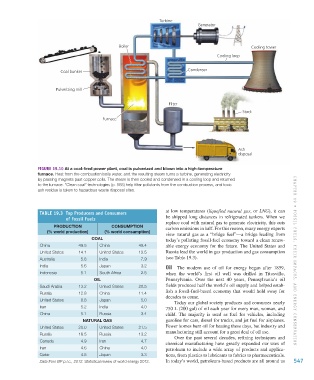Page 548 - Environment: The Science Behind the Stories
P. 548
Turbine
Generator
Boiler Cooling tower
Cooling loop
Coal bunker Condenser
Pulverizing mill
Filter
Stack
Furnace
Ash
disposal
FIGURE 19.10 At a coal-fired power plant, coal is pulverized and blown into a high-temperature
furnace. Heat from the combustion boils water, and the resulting steam turns a turbine, generating electricity
by passing magnets past copper coils. The steam is then cooled and condensed in a cooling loop and returned
to the furnace. “Clean coal” technologies (p. 555) help filter pollutants from the combustion process, and toxic
ash residue is taken to hazardous waste disposal sites.
TABLE 19.3 Top Producers and Consumers at low temperatures (liquefied natural gas, or LNG), it can
of Fossil Fuels be shipped long distances in refrigerated tankers. When we
replace coal with natural gas to generate electricity, this cuts
PRODUCTION CONSUMPTION carbon emissions in half. For this reason, many energy experts
(% world production) (% world consumption)
view natural gas as a “bridge fuel”—a bridge leading from
COAL today’s polluting fossil-fuel economy toward a clean renew-
China 49.5 China 49.4 able energy economy for the future. The United States and
United States 14.1 United States 13.5 Russia lead the world in gas production and gas consumption
Australia 5.8 India 7.9 (see Table 19.3). CHAPTER 19 • FOSSIL FUELS, THEIR IMPA CT S, AND ENERGY CONSERVATI ON
India 5.6 Japan 3.2 Oil The modern use of oil for energy began after 1859,
Indonesia 5.1 South Africa 2.5 when the world’s first oil well was drilled in Titusville,
OIL Pennsylvania. Over the next 40 years, Pennsylvania’s oil
Saudi Arabia 13.2 United States 20.5 fields produced half the world’s oil supply and helped estab-
lish a fossil-fuel-based economy that would hold sway for
Russia 12.8 China 11.4
decades to come.
United States 8.8 Japan 5.0
Today our global society produces and consumes nearly
Iran 5.2 India 4.0 750 L (200 gal) of oil each year for every man, woman, and
China 5.1 Russia 3.4 child. The majority is used as fuel for vehicles, including
NATURAL GAS gasoline for cars, diesel for trucks, and jet fuel for airplanes.
United States 20.0 United States 21.5 Fewer homes burn oil for heating these days, but industry and
manufacturing still account for a great deal of oil use.
Russia 18.5 Russia 13.2
Over the past several decades, refining techniques and
Canada 4.9 Iran 4.7
chemical manufacturing have greatly expanded our uses of
Iran 4.6 China 4.0 petroleum to include a wide array of products and applica-
Qatar 4.5 Japan 3.3 tions, from plastics to lubricants to fabrics to pharmaceuticals.
Data from BP p.l.c., 2012. Statistical review of world energy 2012. In today’s world, petroleum-based products are all around us 547
M19_WITH7428_05_SE_C19.indd 547 12/12/14 5:22 PM

